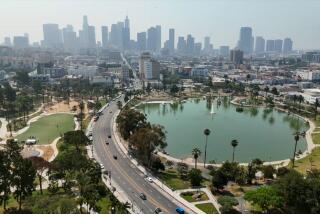Postscript : She’d Prefer to Forget Memory Lane Incident
- Share via
Hazel Woodsworth would rather forget the afternoon she turned a corner in Santa Ana, encountered a policeman and a $52 ticket, and became a symbol in a neighborhood battle with City Hall.
Woodsworth, 87, a widow on a fixed income, was on her way to ask a social agency for help in paying a bill when she turned right from Memory Lane onto Flower Street--overlooking the newly posted no-turn signs.
“The next thing I knew, along came Mr. Cop,” she said. “It is ridiculous. All I did was turn right on that street. I didn’t do any speeding or anything like that, and the police came lickety-split.”
She didn’t know that residents in the old, stately homes on and around Flower Street recently had convinced the City Council to follow a traffic consultant’s recommendations and reroute commuter traffic away from their neighborhood.
1st Ticket in 20 Years
Woodsworth would rather forget that ticket two years ago, her first in 20 years. But residents angry about the detour, part of the North-Central Santa Ana Traffic Plan, continue to battle the re-routing.
The controversial traffic plan, which has met opposition since it was implemented in April, 1985, still awaits a hearing in the Fourth Appellate Court. Under the plan, traffic is rerouted away from Flower and Ross streets at 17th Street to keep commuter traffic out. Commuters instead are directed to and from the Santa Ana and Garden Grove freeways along Broadway, Bristol and Main streets.
When the first traffic measures went into place, elated Flower Street residents could back out of their driveways again. But commuters ticketed at the Memory Lane stop sign began taking their citations to court, where a presiding municipal judge agreed the warning signs were inadequate and began dismissing the tickets. In response, the city erected more signs.
The traffic plan also infuriated other residents near Flower Street, who watched increasing numbers of commuters find alternate routes down their streets. That anger, fueled by news in an anti-poverty agency newsletter about Woodsworth’s ticket, lead to the formation of Concerned Residents of Santa Ana (CROSA) to repeal the traffic measures.
The group, contending that the plan serves 500 people and ignores thousands of neighbors, submitted a petition to the city with 3,000 signatures opposing the traffic plan to no avail. The residents group filed suit in October, 1985. The following February, a Superior Court judge ruled for CROSA, ordering the city to rescind the traffic control measures.
The city attorney appealed the decision, and a hearing is expected by early next year. Milo DeArmey, the attorney for CROSA, said his request to expedite a hearing was denied.
In the meantime, “police have turned their backs on the Memory Lane” area and are not issuing tickets, said City Councilman John Acosta, who represents the area and supported many of the traffic control measures.
Maureen Thomas, Santa Ana police spokeswoman, said there is no “selective enforcement” at the corner, but “if a violator were spotted by an officer, the offender would be ticketed.”
Greenleaf Street residents previously had pledged $9,500 for a wall to block their street from traffic and commercial parking, but did not get city approval. And residents on Victoria Drive have petitioned City Hall for permission to construct put barriers--at their own cost--at either end of their street to block non-resident traffic.
Acosta agreed that “each and every neighborhood has a right to resent out-of-town commuters speeding down their residential streets.” But he predicted a “never-ending problem. It is just going to shift from one area to another until you can prohibit commuter traffic from going through all residential neighborhoods.”
More to Read
Sign up for Essential California
The most important California stories and recommendations in your inbox every morning.
You may occasionally receive promotional content from the Los Angeles Times.










